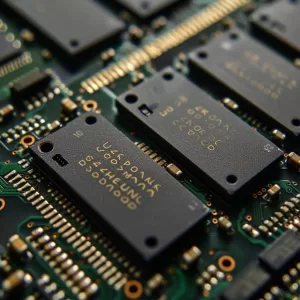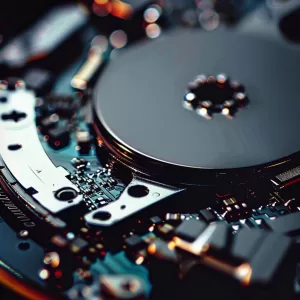
SSD vs HDD: A Comprehensive Comparison
April 12 2024 
Inquiry
Global electronic component supplier AMPHEO PTY LTD: Rich inventory for one-stop shopping. Inquire easily, and receive fast, customized solutions and quotes.
QUICK RFQ
ADD TO RFQ LIST
In this blog, we will dissect both SSDs and HDDs, helping you understand their inner workings, strengths, and weaknesses.
What are SSDs?

How Many SSDs Can a PC Have?
There's no limit to the number of SSDs you can install in your PC, as long as you have available storage bays and SATA (Serial ATA) or PCI-Express (PCIe) slots for connection. However, most users only need one SSD for their operating system and frequently used programs.What do SSDs do?
SSDs serve the same purpose as HDDs in storing data, programs, and operating systems. They do this with substantially faster read and write rates, resulting in a far faster and more responsive computer experience.What is an HDD?

Video related to SSD vs HDD
How do SSDs Work?
- Flash Memory Chips: SSDs rely on NAND flash memory, which is made up of transistors that can trap electrons. The chips store information in the form of a binary code by trapping these electrons. The existence or absence of an electron corresponds to these binary digits.
- Trapped Electrons: Unlike RAM, which loses data when power is turned off, NAND flash memory is non-volatile. This implies that the trapped electrons remain in place even without a power source, allowing the SSD to preserve information.
- Reading and Writing Data: The SSD's controller chip handles reading and writing data. It receives computer commands and manipulates flash memory cells using electrical charges. By applying different voltages, the controller can write data by turning transistors on or off (depending on whether a 0 or 1 is required) and read data by detecting the presence or absence of electrons.
How do SSDs Store Data?
Solid State Drives (SSDs) store data on non-volatile memory known as NAND flash memory. This indicates that the data is retained even after the device is turned off, as opposed to RAM (Random Access Memory), which loses data when power is turned off.How do HDDs Work?
- Platters: The main storage component is a stack of rapidly spinning platters coated in ferromagnetic material. Imagine tiny, round metal disks.
- Read/Write Heads: These are small electromagnets that hover just above the platters without touching them. They behave like arms that can move across the platters.
- Data Storage: Data is stored by magnetizing small portions of the platters. The read/write head generates a magnetic field that reverses the polarity of these regions, yielding a binary code of 0s (one direction) and 1s (the opposite direction).
- Reading Data: The read/write head can detect the magnetic orientation of these regions, allowing it to retrieve the stored data. The direction of magnetism indicates whether the head is a 0 or a 1.
- Positioning the Heads: To access the needed data, a precise actuator arm mechanism moves the read/write heads to exact points on the spinning platters.
Are SSDs Faster than HDDs?
Yes. SSDs provide much faster read and write rates thanks to the lack of mechanical movement. This results in speedier boot times, program loading, and a more responsive overall user experience.SSD vs HDD
SSD (Solid State Drive) and HDD (Hard Disk Drive) are both types of computer storage devices, although they use different technologies that have distinct benefits and disadvantages. Here's an overview of the main differences: Technology:- SSD: SSDs use flash memory chips, similar to USB devices, to store data electronically. No moving parts.
- HDD: HDDs use fast rotating platters coated with magnetic material and a read/write head to magnetically store data.
- SSD: SSD is significantly faster. Electronic access allows faster reading and writing of data. Makes your computer boot up and programs run faster.
- HDD: slower. Accessing data requires physical movement of the head, which results in slower boot times and program loading.
- SSD: SSDs are more durable since they lack moving parts. Physical shocks and bumps cause less damage.
- HDD: HDDs are more prone to damage because of their rotating platters and read/write heads. Sensitive to shocks and motions.
- SSD: SSD typically provides less storage capacity at a higher price per gigabyte.
- HDD: Provide greater storage capacity at a lower cost per gigabyte. Perfect for storing huge data such as movies or video libraries.
- SSD: SSDs require less electricity because they do not include spinning components.
- HDD: Uses more electricity because the platters are always spinning.
- SSD: Completely silent. There are no moving parts that cause noise.
- HDD: Makes noise due to the spinning platters.
- SSD: Due to the complexity of flash memory, data recovery might be more difficult and expensive.
- HDD: HDDs are often easier and less expensive to retrieve data from than SSDs.
Will SSDs Replace HDDs?
The future of storage will most likely feature the coexistence of SSDs and HDDs. SSDs are likely to continue to drop in price per gigabyte while improving in capacity, making them a more practical option for daily use. However, HDDs are expected to remain a low-cost alternative for large-scale storage demands. Here's a breakdown of when each storage option might be the better choice:- Choose an SSD if you value speed, responsiveness, and mobility (laptops, ultrabooks). You typically work on demanding programs such as video editing or gaming.
- Choose an HDD if you need a huge storage capacity at a low cost. You primarily store large media files or archives that do not require high access speeds.
What Improves the Performance of HDDs?
Several factors contribute to SSD performance:- Type of NAND Flash: NAND flash types (SLC, MLC, TLC, and QLC) differ in terms of performance and longevity. In general, SLC provides the quickest speeds and the greatest endurance, but at a considerable cost. TLC and QLC are the least expensive per gigabyte, however they have lower write speeds and endurance.
- Controller: The SSD controller is critical in managing data transmission and wear-leveling, which affects performance.
Where are SSDs Used?
- Laptops and ultrabooks: Improve boot time, program loading, and overall responsiveness.
- High-performance desktops: High-performance desktops are ideal for gamers, video editors, and anyone who needs a quick and responsive PC.
- Gaming consoles: SSDs are commonly used in newer generation consoles to improve game loading times and in-game experiences.
- Mobile devices: SSDs are increasingly being used in smartphones and tablets to speed up app startup and performance.
Where are HDDs Used?
- Personal Computers: While SSDs are becoming more popular in personal computers, HDDs remain a popular secondary storage option, particularly for customers who want a large amount of storage space for items such as films, music libraries, or large game files.
- Data Centers: Many data centers use HDDs for bulk data storage. This is because hard disk drives (HDDs) provide a low-cost means to store large volumes of data that do not require quick access times, such as archives, backups, or log files.
- Surveillance Systems: Video surveillance systems frequently use HDDs to store recorded footage. Because surveillance footage might be large, HDDs provide adequate capacity at a reasonable price.
- External Storage: External hard drives, which are used to backup data or transmit huge files between computers, are primarily HDDs due to their lower cost per gigabyte than SSDs.
How Long do SSDs Last?
An SSD's lifespan is determined by a variety of factors, although with typical use, it should survive many years, often exceeding five years.How Long do HDDs Last?
The lifespan of an HDD (Hard Disk Drive) is typically expected to be 3-5 years, though this might vary based on a variety of factors.Conclusion
The conflict between SSDs and HDDs is no longer clear-cut. SSDs have grown more inexpensive, and capacity continues to grow. HDDs, on the other hand, continue to be the best value for raw storage space. Whatever technique you use, keep in mind the importance of regular backups. Data loss can occur on any storage device, so keeping a secure copy of your key files is critical. Are SSDs Faster than HDDsConclusionHow Long do HDDs LastHow Long do SSDs LastWhere are HDDs UsedWhere are SSDs UsedWhat Improves the Performance of HDDsWill SSDs Replace HDDsSSD vs HDDWhat are SSDsHow do HDDs WorkHow do SSDs Store DataHow do SSDs WorkVideo related to SSD vs HDDWhat is an HDDWhat do SSDs doHow Many SSDs Can a PC Have
Related Articles
- ·Stratix 10 VS Stratix V: Which FPGA is Right for Your Next Project?
- ·Intel Xeon Platinum 8454H vs AMD EPYC: Which Reigns Supreme?
- ·A Deep Dive into the AMD EPYC 4564P Processor
- ·MSP430F5438A vs MSP430F5529: A Detailed Analysis of Their Capabilities
- ·Comparing MSP430F6659 and MSP430F5419A: Which One is Right for Your Project?
- ·Exploring the Features of MSP430F5529 and MSP430F5638 Microcontrollers
- ·Demystifying 20 Microcontroller Projects for Beginners
- ·Unveiling the Ultimate Guide to Microcontroller Programming
- ·4680 Battery: Unveiling the Power Potential of the Next-Gen Cell
- ·Exploring the Case Studies on Arduino Applications
